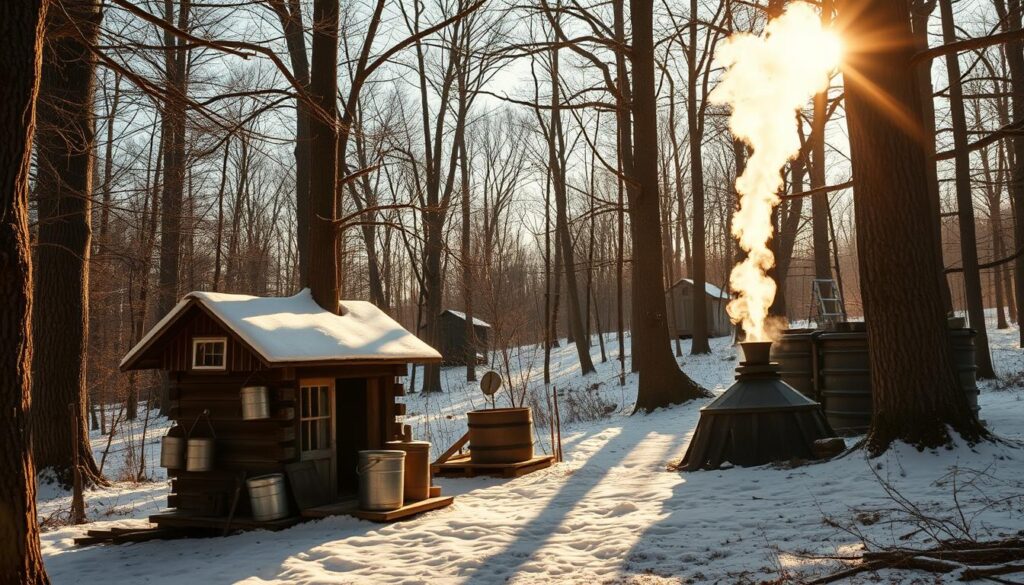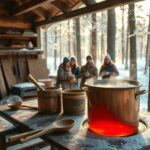Discover the golden magic of pure maple syrup. It turns ordinary meals into extraordinary culinary experiences. What is maple syrup, you ask? It’s a natural treasure with deep roots in North American tradition.
It’s made through a complex process starting deep in forest landscapes. This liquid gold begins its journey in maple trees. It’s extracted using time-honored techniques passed down through generations.
Each drop is a complex transformation from tree sap to rich, amber-colored syrup. It delights taste buds and offers unique nutritional benefits.
Pure maple syrup is more than just a sweetener. It’s a symbol of sustainable agricultural practices. It connects consumers with traditional food production methods that respect natural ecosystems.
Farmers and producers invest significant expertise in capturing this delicate nectar. They ensure every bottle represents quality and authenticity.
From breakfast tables to gourmet kitchens, maple syrup offers more than just sweetness. Its complex flavor profile ranges from delicate light grades to robust dark varieties. This makes it a versatile ingredient that elevates both sweet and savory dishes.
In this guide, you’ll explore the fascinating world of maple syrup. You’ll learn about its origins, production techniques, nutritional advantages, and the process that transforms simple tree sap into a cherished natural sweetener enjoyed worldwide.
What Is Maple Syrup
Maple syrup is a natural sweetener with a long history in North America. It comes from the sap of maple trees. This process turns the sap into a golden liquid with a pure flavor.
Pure maple syrup is different from artificial sweeteners. It starts in the maple trees’ network. Here, a special ecosystem helps make this valuable ingredient.
The Natural Origins of Maple Sap
Maple sap is the lifeblood of maple trees. In late winter and early spring, these trees store starches. These starches turn into sugar, which is key for making maple syrup.
- Maple trees store sugar reserves in their roots
- Seasonal temperature changes trigger sap flow
- Specific maple species are ideal for syrup production
From Tree to Table Process
Turning maple sap into syrup needs skill and care. Sugarmakers tap maple trees to get the sap. They make small holes in the tree trunks.
“Each drop of maple syrup represents hours of careful craftsmanship and natural wonder.” – Traditional Sugarmaker’s Wisdom
Understanding Pure vs. Artificial Maple Syrup
Pure maple syrup is very different from fake ones. Real maple syrup has natural minerals and antioxidants. But, fake syrups often use corn syrup and artificial flavorings.
| Pure Maple Syrup | Artificial Maple Syrup |
|---|---|
| 100% Natural | Processed Ingredients |
| Mineral-Rich | Limited Nutritional Value |
| Complex Flavor Profile | Simplified Taste |
Maple syrup production is a mix of nature and human skill. It turns simple tree sap into a treasured food item loved around the world.
The Rich History of Maple Syrup Production
The history of maple syrup goes back centuries. It started with Native American tribes in North America. They were the first to find the sweet sap of maple trees.
They used their own ways to collect and boil down the sap into syrup.
When European settlers came to Vermont, they learned from the Native Americans. They took their knowledge and made maple syrup a big deal in the area.
By the 1800s, Vermont was leading in maple syrup production. Farmers got better at tapping trees, using metal spouts instead of buckets. They also improved how they boiled the sap to make syrup.
Vermont’s climate and lots of sugar maple trees made it perfect for syrup production.
“Maple syrup is more than a sweet treat—it’s a connection to our agricultural heritage.” – Vermont Maple Syrup Historian
In the 1900s, new tech changed how syrup was made in Vermont. Today, sugarmakers use vacuum lines and efficient evaporators. But they also keep the old ways alive.
- First commercial maple syrup operations emerged in the 1800s
- Technological innovations improved production efficiency
- Vermont remains the top maple syrup-producing state in the United States
How Maple Syrup Is Made: Modern Production Methods
Maple Syrup Production has become a complex process. It turns tree sap into tasty pure maple syrup. Sugarmakers in North America use old knowledge and new tech to make this sweet treat.
The journey starts in the forest, where maple trees are key. Modern methods need precision, skill, and advanced tools for top-quality syrup.
Tapping and Collection Techniques
Maple tree tapping is done carefully to protect the tree and get sap:
- Select mature maple trees (typically 40+ years old)
- Use specialized tapping tools with minimal tree damage
- Install modern collection systems with vacuum technology
- Monitor tree health and sap flow rates
Evaporation and Processing Steps
Turning raw sap into pure maple syrup is a detailed process:
- Collect fresh sap within hours of extraction
- Filter and remove debris from collected sap
- Use high-efficiency evaporators to concentrate sugars
- Carefully monitor temperature and sugar content
Quality Control Measures
Producers follow strict quality control for the best syrup:
- Regular laboratory testing for sugar concentration
- Strict hygiene protocols during production
- Grading systems to ensure consistent quality
- Temperature and density monitoring
Maple Syrup Production is a mix of old craft and new science.
Understanding Maple Syrup Grades and Classifications
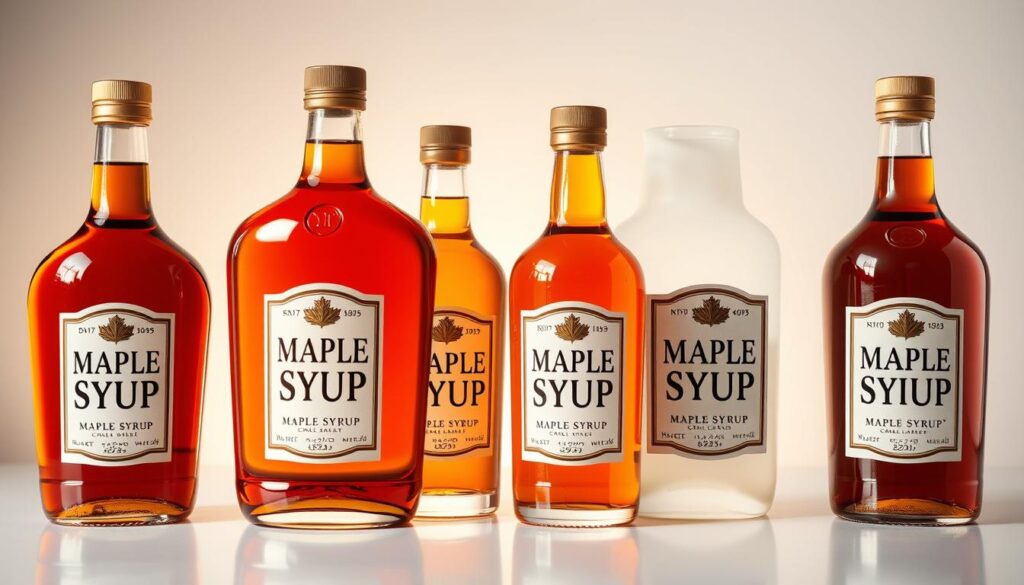
Pure maple syrup is more than just a sweetener. It’s a product with different grades that show its unique qualities. These grades help us understand the syrup’s flavor, color, and quality.
The United States Department of Agriculture has four main grades of pure maple syrup. Each grade gives a different taste experience:
- Golden Color, Delicate Taste: The lightest grade, with a mild maple flavor perfect for those who prefer subtle sweetness
- Amber Color, Rich Taste: A more pronounced maple flavor, ideal for traditional pancake topping
- Dark Color, Robust Taste: Stronger maple notes that work well in baking and cooking
- Very Dark Color, Strong Taste: The most intense maple flavor, best for industrial food processing
Choosing the right maple syrup grade depends on what you like and how you plan to use it. Sugarmakers watch the syrup’s color and flavor closely. They make sure each batch meets high quality standards.
When buying pure maple syrup, check the label for the grade and where it’s from. Real maple syrup is a natural, minimally processed sweetener. It has unique flavors that artificial sweeteners can’t match.
Nutritional Benefits of Pure Maple Syrup
Pure maple syrup is more than a sweetener. It has many Maple Syrup Nutrition benefits. Unlike refined sugars, it has minerals and compounds that are good for you.
Essential Minerals and Antioxidants
Maple syrup is not just tasty. It’s also full of nutrients that help your health:
- Zinc: Supports immune function
- Manganese: Helps bone health and metabolism
- Calcium: Strengthens bones and teeth
- Potassium: Regulates heart function
Studies show maple syrup has over 24 antioxidants. These help protect cells from damage and may lower disease risk.
Comparing Maple Syrup to Other Sweeteners
Maple syrup is different from other sweeteners. White sugar has no nutrients, but maple syrup has minerals and compounds. It’s also a natural product with little processing.
Health Considerations and Glycemic Index
Maple syrup has a lower glycemic index than regular sugar. This means it raises blood sugar levels slower. Moderation is important because it’s sugar, but it’s a better choice.
A single tablespoon of pure maple syrup contains more nutritional value than many people realize.
Vermont: America’s Maple Syrup Capital
Vermont is the top producer of maple syrup in the United States. Its geography is perfect for maple trees, making it a leader in the industry.
The state makes a lot of maple syrup every year. It’s a big part of the country’s syrup production. Vermont’s syrup makers have several advantages:
- Perfect climate with cold nights and warm days
- Dense maple forest landscapes
- Generational expertise in Maple Syrup Production
- Strict quality control standards
Maple syrup is more than a product in Vermont—it’s a cultural tradition. Sugarmakers there have developed advanced methods to make syrup from tree sap. They keep high quality standards.
The maple syrup industry is big for Vermont’s economy. Small and big sugarbushes bring in millions of dollars each year. Every spring, people come to see the maple syrup making process.
“In Vermont, maple syrup isn’t just a product—it’s a way of life.”
Vermont’s maple community is always finding new ways to improve. They use the latest tapping technologies and manage forests sustainably. The state stays ahead in maple syrup innovation.
Storing and Preserving Maple Syrup
Keeping maple syrup in top shape is key. Whether it’s a special bottle you bought or a gift, knowing how to store it right is important. This way, you can enjoy its rich taste for a long time.
Maple syrup needs special care to avoid spoilage. It has its own storage needs to keep its quality and taste just right.
Proper Storage Techniques
- Store unopened pure maple syrup in a cool, dark pantry
- After opening, always refrigerate the syrup
- Use airtight containers to prevent contamination
- Keep away from direct sunlight and heat sources
Shelf Life Guidelines
The shelf life of maple syrup depends on how you store it. Unopened pure maple syrup can last up to two years when stored properly. Once opened, it’s best to use it within a year.
Signs of Spoilage
Improper storage can ruin maple syrup. Look out for these signs of spoilage:
- Visible mold growth on the surface
- Off-putting smell or unusual color changes
- Crystallization or fermentation
If you see any of these signs, it’s best to throw out the syrup. This keeps your food safe and preserves the maple flavor.
Culinary Uses and Applications
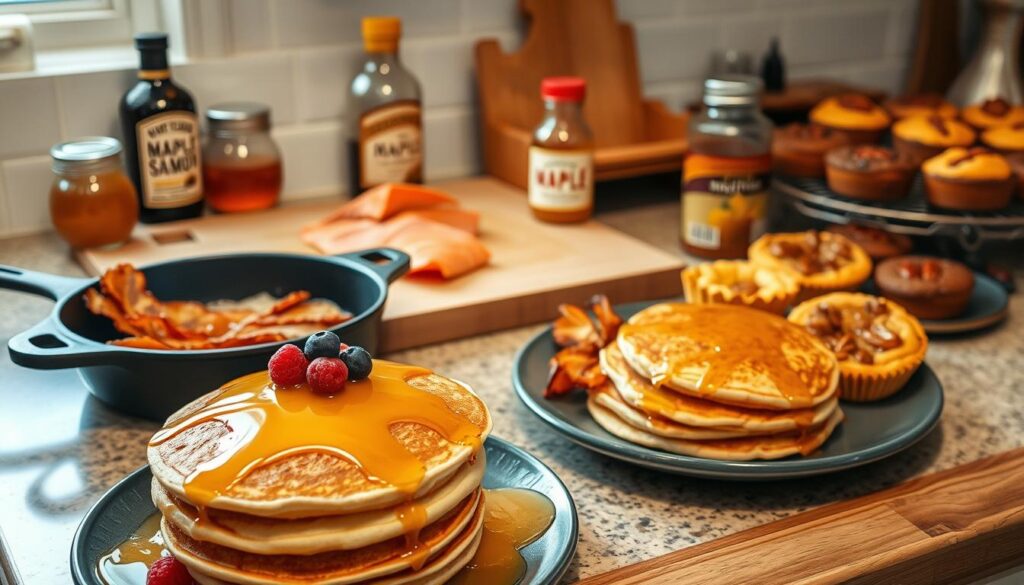
Maple syrup makes simple dishes into amazing meals. It adds a rich, complex flavor that makes both sweet and savory dishes better.
Chefs and home cooks find creative ways to use maple syrup. It brings a unique taste to breakfast, lunch, and dinner.
- Breakfast Innovations:
- Maple-glazed bacon
- Overnight oatmeal with maple drizzle
- Maple yogurt parfaits
- Savory Meal Enhancements:
- Maple-roasted vegetables
- Maple-bourbon marinades
- Maple-infused salad dressings
- Dessert Creations:
- Maple pecan pie
- Maple frosting
- Maple crème brûlée
When using maple syrup in recipes, remember it’s sweeter than sugar. Use ¾ cup of maple syrup for every cup of sugar. Also, cut down other liquids by about ¼ cup to keep the recipe right.
“Maple syrup isn’t just a condiment—it’s a culinary adventure waiting to be explored.” – Professional Chef Interview
Trying out maple syrup can lead to many tasty discoveries. It turns old recipes into fancy dishes that everyone will love.
Seasonal Harvesting and Best Times to Buy
Vermont Maple Syrup production is a special event that happens in winter’s last weeks. It’s a time of celebration for the sweet harvest. The maple syrup season is a delicate balance of temperature, tree biology, and sugarmaker skill.
Maple syrup production needs the right environmental conditions. The sap flows best when it’s cold at night and warm during the day. This mix of temperatures makes the sap move in the trees.
Understanding the Maple Season
The maple syrup season usually lasts 4-6 weeks, from late February to early April. Sugarmakers watch the weather closely to get the most syrup.
- Late Winter/Early Spring: Peak maple sap collection period
- Nighttime temperatures: Below 32°F
- Daytime temperatures: Above 40°F
- Typical season duration: 4-6 weeks
Price Fluctuations and Availability
Maple syrup prices change with the season. Costs are affected by how much syrup is made, the weather, and how much people want it.
| Season | Typical Price Range | Availability |
|---|---|---|
| Peak Season | $12-$18 per quart | High |
| Off-Season | $16-$22 per quart | Limited |
For the best taste, buy premium quality syrup directly from Vermont sugarmakers during the main harvest. This way, you get the freshest syrup.
Sustainability in Maple Syrup Production
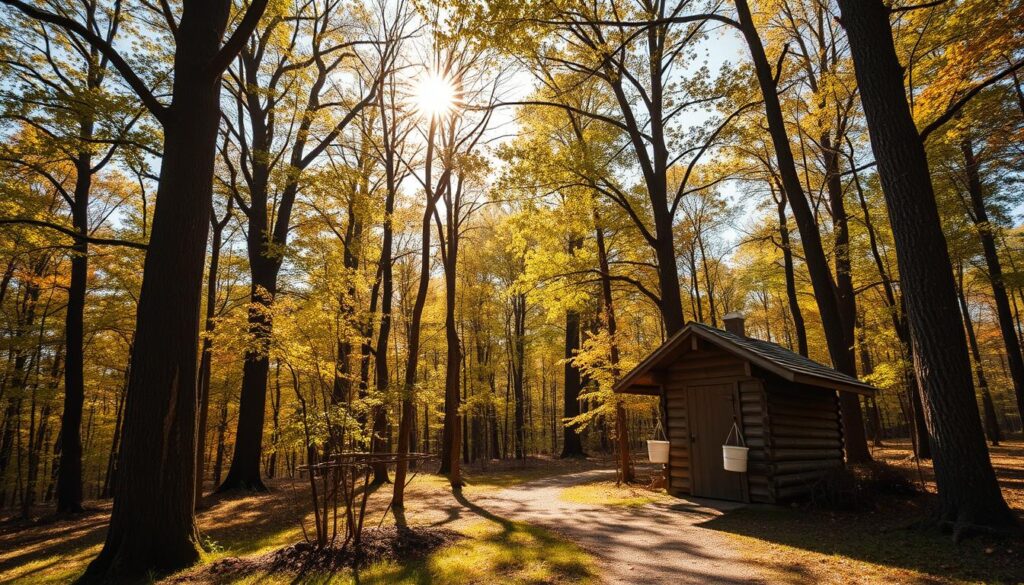
Maple syrup making is a fine balance between old ways and caring for the environment. Sugarmakers in North America use green practices. These methods keep forests healthy and syrup quality high.
Key parts of green maple syrup making include:
- Responsible forest management
- Minimizing ecological disruption
- Protecting maple tree health
- Implementing conservation techniques
Today’s maple syrup makers watch over tree health and use careful tapping. Sustainable harvesting lets trees keep making sap for many years. Trees must be at least 40 years old and 10 inches thick before tapping starts.
| Sustainability Practice | Environmental Impact |
|---|---|
| Limited Tapping per Tree | Prevents tree damage and promotes long-term forest health |
| Forest Biodiversity Protection | Maintains ecosystem balance and wildlife habitats |
| Renewable Energy in Processing | Reduces carbon footprint during maple syrup production |
New tech helps sugarmakers keep an eye on forest health and syrup making. They use smart tapping and forest care plans. This keeps the environment safe and syrup quality top-notch.
“Sustainability isn’t just about production—it’s about preserving a natural legacy for future generations.” – Vermont Maple Sugar Makers Association
Maple syrup makers focus on keeping forests healthy. They make sure syrup is pure and top-quality. This shows their dedication to the environment and their craft.
Common Myths and Misconceptions About Maple Syrup
Many people have wrong ideas about maple syrup. They don’t know what it is or how it’s made. Learning the truth can help us appreciate this natural sweetener more.
Maple syrup is more than just a sweetener. It’s a natural product with deep cultural roots and complex production methods. It’s not just a simple sweetener.
Debunking Popular Beliefs
- Myth: All maple syrups taste the same
Reality: The taste of maple syrup changes based on its grade. Grades range from light to strong, depending on when it’s harvested and how it’s made.
- Myth: Maple syrup is just sugar
Reality: Maple syrup has minerals like manganese, zinc, and antioxidants. These are not in refined sugars.
- Myth: Maple syrup can be stored indefinitely
Reality: If not stored right, maple syrup can turn grainy or spoil. It needs special care to keep it good.
Understanding Quality Indicators
| Quality Indicator | Good Maple Syrup Characteristics | Poor Quality Signs |
|---|---|---|
| Color | Consistent, clear amber tone | Cloudy or uneven coloration |
| Texture | Smooth, uniform consistency | Grainy or separated appearance |
| Aroma | Sweet, distinct maple fragrance | Musty or off-putting smell |
“Understanding maple syrup is about appreciating its natural complexity and respecting its traditional production methods.” – Maple Syrup Artisan
By clearing up these myths, we can choose better maple syrup. Knowing more about it helps us enjoy it more.
Choosing and Buying Quality Maple Syrup
Finding the right pure maple syrup is all about knowing what makes it special. It’s about understanding the qualities that set top-notch syrup apart. This knowledge can elevate your cooking and ensure you get the real deal.
When you’re looking for pure maple syrup, keep these tips in mind:
- Make sure it’s 100% pure maple syrup with no added sugars or artificial stuff
- Check the Maple Syrup Grades – they show different flavors and colors
- Choose syrup from well-known maple-producing places like Vermont
- Opt for clear packaging so you can see the syrup’s color and clarity
Knowing about Maple Syrup Grades is key to making smart choices. The grading system usually includes:
- Golden Color, Delicate Taste: Lightest grade, mild flavor
- Amber Color, Rich Taste: Medium amber color with robust maple flavor
- Dark Color, Robust Taste: Darker syrup with intense maple characteristics
- Very Dark Color, Strong Taste: Deepest color with most pronounced maple notes
While price can hint at quality, it’s not everything. Artisanal makers often create the best syrup through careful methods. Always choose based on taste, authenticity, and how it’s made.
Pro tip: Buy maple syrup from local farmers’ markets or sugarhouses for the freshest taste.
Conclusion
Maple syrup is more than a tasty sweetener. It’s a key part of North American culture and history. The process of making maple syrup is complex and sustainable. It involves careful harvesting and generations of maple farming knowledge.
Maple syrup has many benefits that set it apart from artificial sweeteners. It’s full of minerals and has a unique taste. This makes it a healthier and more flavorful choice than processed sugar.
The journey from the forest to your table shows the skill of sugarmakers. They keep this traditional art alive. This journey highlights their dedication and craftsmanship.
Maple syrup is not just for breakfast or baking. It’s used in many ways, from topping pancakes to adding flavor to marinades. It’s loved by food lovers and those who care about health. Its production is sustainable, making it a special natural product.
As people look closer at where their food comes from, maple syrup shines. It shows the value of traditional food making that cares for nature and heritage. Choosing pure maple syrup supports a tradition that connects us to the earth and its gifts.

